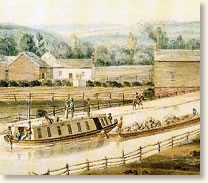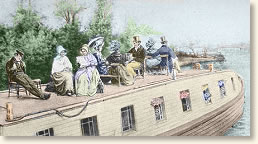|
Traveling the Erie Canal, 1836
It was the engineering marvel of its time - its construction compared to the building of the pyramids of Ancient Egypt. The idea for a canal connecting the Hudson River and the Great Lakes was first proposed in the early 1800s by a miller living in a village in upstate New York. President Thomas Jefferson declared the idea "little short of madness",
 |
| The Canal ca. 1830 |
but Dewitt Clinton, then Mayor of New York City, championed the concept. When Clinton became Governor of the state, he pushed through legislation funding the construction of the canal - Clinton's "Big Ditch" (also dubbed "Clinton's Folly") was born. The massive job was begun in 1817 and completed in 1825.
The canal's opening ignited the first great western migration. Thousands of settlers skirted the natural barrier of the Allegheny Mountains and moved to the fertile lands of Ohio, Indiana, Illinois, and beyond. Soon, canal boats were hauling the agricultural bounty (particularly wheat) of the new Frontier along the canal to mills in the East. The same boats made the return trip laden with finished goods for eager customers in the West.
This lucrative trade made New York City America's busiest port and a commercial powerhouse. The Canal remained America's major commercial highway for some 50 years until it was eclipsed by the railroads.
The Erie Canal was the transportation marvel of its day. It reduced the travel time from the Hudson River to the Great Lakes by one half and provided travelers a welcome alternative to the rutted, muddy road of the stage coach. Passengers traveled on packet boats pulled by a team of horses or mules at a leisurely pace equivalent to that of a fast walk.
In 1836 Thomas S. Woodcock made the trip from Schenectady, New York to Buffalo and recorded his experience aboard a packet boat:
"These boats are about 70 feet long, and with the exception of the Kitchen and bar, is occupied as a Cabin. The forward part being the ladies' Cabin, is separated by a curtain, but at meal times this obstruction is removed, and the table is set the whole length of the boat. The table is supplied with every thing that is necessary and of the best quality with many of the luxuries of life.
On finding we had so many passengers, I was at a loss to know how we should be accommodated with berths, as I saw no convenience for anything of the kind, but the Yankees, ever awake to contrivances, have managed to stow more in so small a space than I thought them capable of doing.
The way they proceed is as follows - the Settees that go the whole length of the Boat on each side unfold and form a cot bed. The space between this bed and the ceiling is so divided as to make room for two more. The upper berths are merely frames with sacking bottoms, one side of which has two projecting pins, which fit into sockets in the side of the boat. The other side has two cords attached one to each corner. These are suspended from hooks in the ceiling. The bedding is then placed upon them, the space between the berths being barely sufficient for a man to crawl in, and presenting the appearance of so many shelves. Much apprehension is always entertained by passengers when first seeing them, lest the cords should break. Such fears are however groundless.
The berths are allotted according to the way bill, the first on the list having his first choice, and in changing boats the old passengers have the preference. The first Night I tried an upper berth, but the air was so foul that I found myself sick when I awoke. Afterwards I chose an under berth and found no ill effects from the air.
These Boats have three Horses, go at a quicker rate, and have the preference in going through the locks, carry no freight, are built extremely light, and have quite Genteel Men for their Captains, and use silver plate. The distance between
 |
| A Packet Boat |
Schenectady and Utica is 80 Miles, the passage is $3.50, [equivalent to approximately $69.00 in today's money] which includes board. There are other Boats called Line Boats that carry at a cheaper rate, being found for 2/3 of the price mentioned. They are larger Boats, carry freight, have only two horses, and consequently do not go as quickly and moreover have not so select a company. Some boats go as low as 1 cent per mile."
"The Bridges on the Canal are very low, particularly the old ones. Indeed they are so low as to scarcely allow the baggage to clear, and in some cases actually rubbing against it. Every Bridge makes us bend double if seated on anything, and in many cases you have to lie on your back. The Man at the helm gives the word to the passengers: 'Bridge,' 'very low Bridge,' 'the lowest in the Canal,' as the case may be. Some serious accidents have happened for want of caution. A young English Woman met with her death a short time since, she having fallen asleep with her head upon a box, had her head crushed to pieces. Such things however do not often occur, and in general it affords amusement to the passengers who soon imitate the cry, and vary it with a command, such as 'All Jackson men bow down.' After such commands we find few aristocrats."
References:
Mr. Woodcock's account appears in: Deoch, Fulton, ed., New York to Niagara, 1836: The Journal of Thomas S. Woodcock (1938); Murphy, Dan, The Erie Canal: the Ditch that Opened a Nation (2001); Shaw Ronald E., Erie Water West; a History of the Erie Canal (1966).
How To Cite This Article:
"Traveling the Erie Canal, 1836", EyeWitness to History, www.eyewitnesstohistory.com (2004).
|






